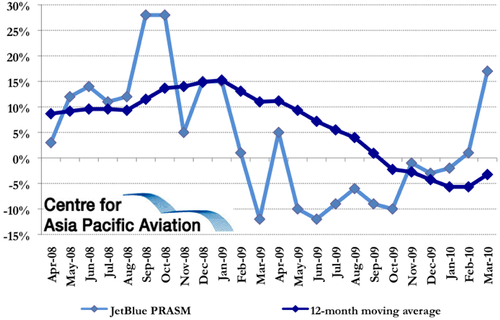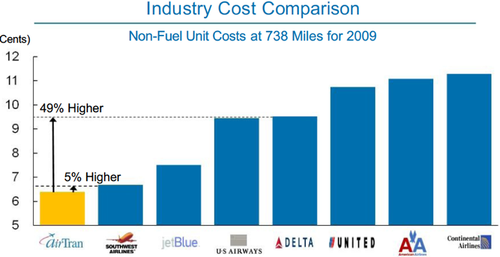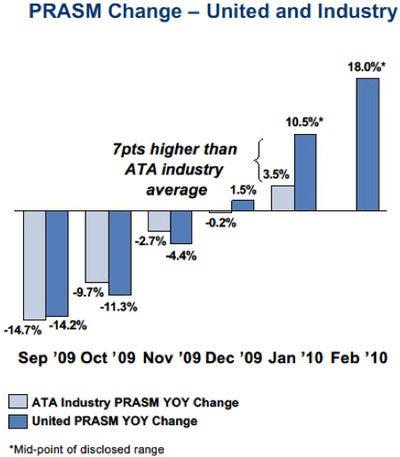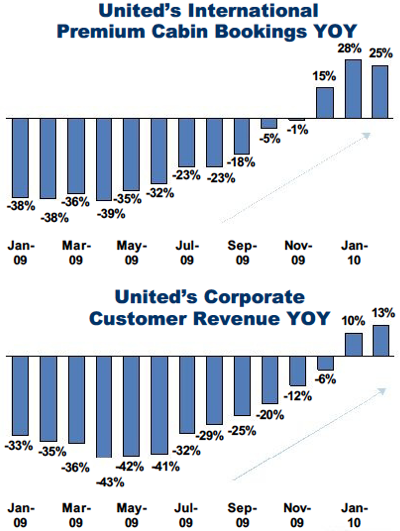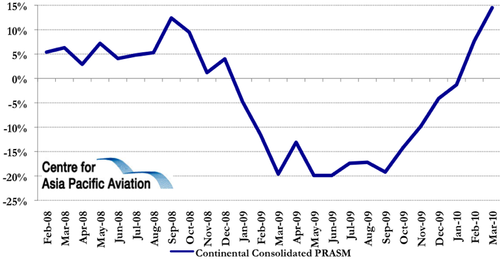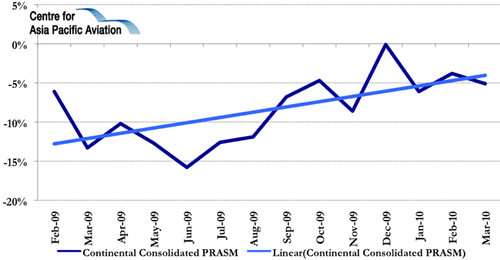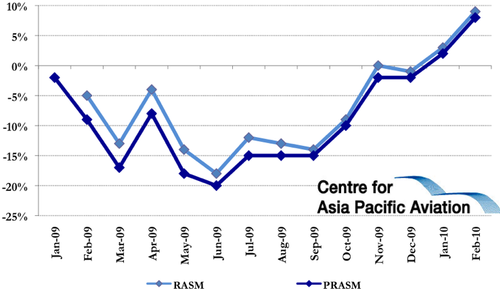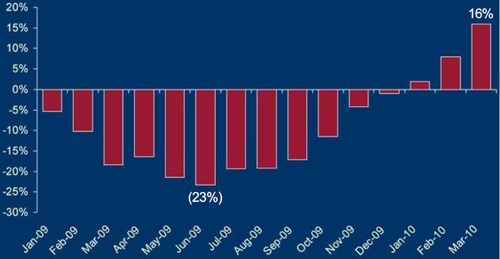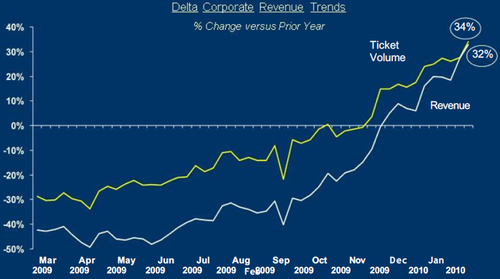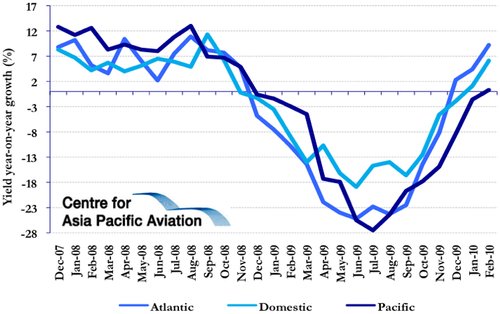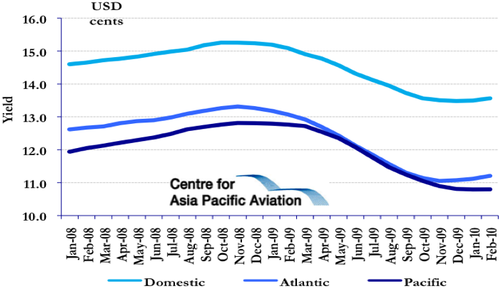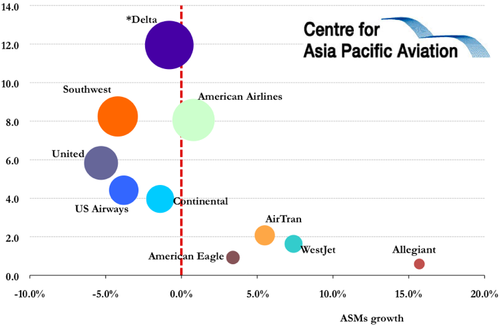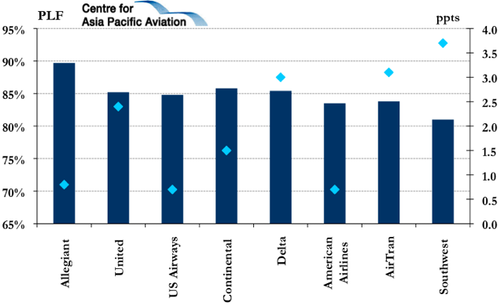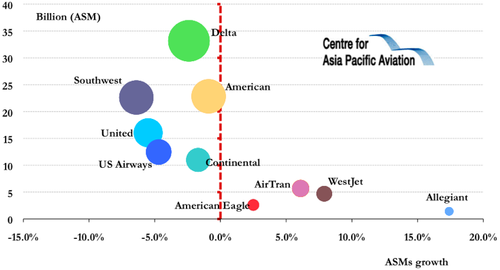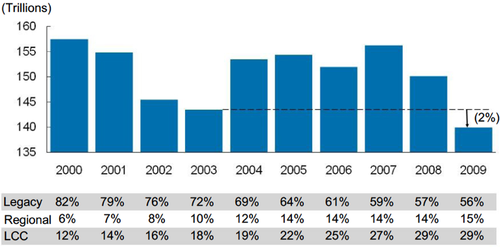Impressive PRASM performance for Southwest & United; US Airways, JetBlue & Continental see growth
Southwest Airlines, the star performer in improving its unit revenues in recent months thanks to its continued capacity disciplin, trumped JetBlue, Continental Airlines and US Airways in the yield growth stakes again in Mar-2010, but was joined by United Airlines in reporting 20%+ year-on-year PRASM growth in the month.
Encouragingly, all the US carriers reporting monthly unit revenue figures experienced double-digit growth in the month, albeit off a weak comparison from Mar-2009. AirTran and Allegiant, which do not provide such updates, previously commented they have seen improved yield conditions in the market.
US airline unit revenue highlights: Mar-2010
|
|
PRASM |
RASM |
|---|---|---|
|
Southwest (Estimated) |
+22% |
n/a |
|
United Airlines (Estimated) |
+21.5% to +23.5% |
n/a |
|
US Airways (Estimated) |
+18% |
+20% |
|
Continental (Estimated) |
+14.5% to +15.5% |
+13.0% to +14.0% |
|
JetBlue (Estimated) |
+17% |
n/a |
Seventh consecutive month of PRASM growth for Southwest
Southwest stated passenger revenue per ASM for Mar-2010 is estimated to have surged 22% in Feb-2010 - its largest PRASM increase in the past 12 months and the seventh consecutive month of PRASM growth for the carrier. The increase compares to a 10-11% RASM reduction in Mar-2009. (NB Southwest did not provide monthly PRASM breakdowns in 2008).
Southwest PRASM year-on-year increase: Jan-2009 to Mar-2010
Last month, Southwest Airlines CFO, Laura Wright, commented that the carrier plans to focus on increasing profits, rather than growing capacity in 2010.
Double-digit PRASM increase for JetBlue
JetBlue reported PRASM increased 17% year-on-year in Mar-2010, following growth of 1% in Mar-2009 and growth of 27% in Mar-2008. The carrier reported PRASM increases of 1-3% in Feb-2010, which was the first month of PRASM improvement since Apr-2009. On a 12-month moving average of PRASM growth, JetBlue has shown a clear uptick in the latest month.
JetBlue PRASM year-on-year increase and 12 month moving average: Apr-2008 to Mar-2010
JetBlue has previously stated it expects PRASM and RASM to be in the range of negative 1-2% in 1Q2010, but some solid improvement thereafter. JetBlue is forecasting PRASM and RASM for the full year to increase in the +5 to +8% range.
Fitch affirms JetBlue Airways at 'B-'; outlook stable
Meanwhile, Fitch Ratings, prior to the most recent traffic release, stated it believes the airline is in a "good position" to deliver improved operating results and a second consecutive year of positive free cash flow as the economy recovers in 2010.
However, Fitch warned that the carrier's plan to grow capacity (ASM) capacity by 5-7% in 2010 may constrain RASM growth relative to other US carriers. Fitch added that it expects JetBlue to report material gains in RASM in 2010 as the economic recovery drives a significant pick-up in traffic while slow industry capacity growth and reduced fare sale activity boosts yields.
Fitch added that given JetBlue's light exposure to high-fare international business traffic, the LCC delivered better unit revenue results than the network carriers during 2009, although, by the same token, it may lag somewhat this year as fare hikes and a pick-up in business demand should help network carriers report better year-on-year RASM comparisons.
In light of this, Fitch believes that full-year 2010 RASM growth in the mid-single digit percentage range is achievable. However, non-fuel unit operating cost pressure remains a concern, as unit labour and maintenance costs have been rising at a high rate in recent quarters. JetBlue earlier stated it expects non-fuel costs per ASM to rise in the range of 3-5% in 2010, down from 6% in 4Q2009.
AirTran seeing "improving" yield trends; cost advantage also exists
Also among the LCCs, AirTran Airways (which does not provide monthly yield updates) last month commented that there is a "favourable industry backdrop going forward", with capacity remaining "disciplined" and yield trends "improving".
During 1Q2010, total unit revenues, as at Mar-2010, were up in the 3.5-4.5% range, with double-digit improvements expected in Mar-2010 and into 2Q2010. The carrier previously stated that it expected total unit revenues in 1Q2010 to be up in the 2.5-3.5% range, indicating an improvement in the yield environment.
The carrier added that it also has a cost advantage among its US counterparts, although AirTran did provide cost data for Allegiant and Spirit.
Non-fuel unit costs among select US carriers
Allegiant seeing RASM, TRASM and fare growth in 1Q2010; lower unit costs
Allegiant stated it anticipates RASM growth of more than 2% in 1Q2010, with a total fare change of at least 5% in the quarter. TRASM is expected to increase by 1% or greater. (Like AirTran, Allegiant does not provide monthly yield/unit revenue updates).
During 2009, Allegiant reported double-digit reductions in total revenue per ASM and average scheduled service fares, of 10.3% and 17.2%, respectively, to USD 10.28 cents and USD70.38, respectively. Average fare declined 9.6% to USD103.45 in the year (the carrier benefited from a 12.4% increase in ancillary average fare to USD33.07).
Meanwhile, Allegiant stated it expects flat ex-fuel costs in 2010, with the carrier stating it has the lowest cost per passenger levels among the nation's LCCs.
Cost per passenger vs stage length among US LCC segment
United Airlines reports largest PRASM improvement in over two years; PRASM up compared to Mar-2008 levels
Among the network carriers, United Airlines reported an estimated increase in consolidated passenger revenue per available seat mile (PRASM) of 21.5% to 23.5% in Mar-2010, for the fourth consecutive month of improvements and the largest year-on-year rise since prior to Jan-2008. Consolidated PRASM is estimated to have increased 3.2% to 5.2% in the month compared to Mar-2008 levels, approximately 3.0 ppts of which are due to growth in ancillary revenues.
United Airlines PRASM growth (%): Jan-2008 to Mar-2010
Thanks to three consecutive months of double-digit RASM growth, United is headed for its first quarter of positive RASM growth in over four quarters. The carrier is seeing "recent revenue improvements" that are "outpacing the industry", driven by improvements in international and business travel demand.
PRASM change: United Airlines and industry
The carrier added that it expects unit revenue per ASM to increase by 16-17% in 1Q2010 (to between USD 11.44 cents and USD 11.54 cents) and a mainline unit revenue increase of 16.5% to 17.5% (to between USD 10.50 cents to USD 10.59 cents). The carrier is also handsomely benefiting from ancillary revenue growth, which generated USD13.17 per passenger in 2009 (up 22.2% year-on-year, and up 70% from 2007 levels).
United Airlines consolidated PRASM developments: 1Q2008 to 4Q2009
|
USD cents |
Consolidated PRASM |
Year-on-year growth |
|---|---|---|
|
1Q2008 |
11.09 |
+8.3% |
|
2Q2008 |
12.39 |
+3.9% |
|
3Q2008 |
13.02 |
+5.2% |
|
4Q2008 |
11.96 |
+2.1% |
|
1Q2009 |
9.86 |
-11.1% |
|
2Q2009 |
10.26 |
-17.2% |
|
3Q2009 |
11.10 |
-14.7% |
|
4Q2009 |
11.34 |
-5.2% |
|
1Q2010E |
11.44 to 11.54 |
-16% to +17% |
United added that international premium cabin bookings were up 8% and 25%, respectively, in Jan-2010 and Feb-2010 (off negative growth of 38% in both Jan-2009 and Feb-2009). Corporate customer revenues also gained, by 10% and 13%, respectively (from negative growth of 33% and 35%, respectively, in the corresponding periods in 2009).
United Airlines international premium cabin bookings and corporate customer revenue: Jan-2009 to Feb-2010
The carrier added that it expects operating cost per ASM (excluding profit sharing and non-cash net mark-to-market impacts), to increase by 6.0% to 6.7% in 1Q2010, with mainline increases in the 5.1% to 5.8% range. Cost per ASM (excluding fuel and profit share) is expected to increase by 4-5%, or by 4.5% to 5.5% for mainline operations.
Continental Airlines' yields improve - best PRASM performance since Dec-2008
Continental reported an encouraging set of traffic results for Mar-2010, with its second consecutive month of positive yield growth, and the largest year-on-year PRASM growth in over two years.
During Mar-2010, consolidated PRASM is estimated to have increased between 14.5% and 15.5%, while mainline RASM is estimated to have increased between 13.0% and 14.0%. For Feb-2010, consolidated PRASM increased 7.7% year-on-year, while mainline passenger RASM increased 5.8% year-on-year.
Continental Airlines consolidated PRASM (US cents per ASM): Feb-2008 to Mar-2010
Looking at a two-year range, Continental's Mar-2010 PRASM was below Mar-2008 levels.
Continental Airlines' consolidated PRASM growth (two year range): Feb-2009 to Feb-2010
Continental ended 1Q2010 with an unrestricted cash, cash equivalents and short-term investments balance of approximately USD3.15 billion, higher than the USD3.1 billion initially expected.
US Airways seeing "positive momentum" in the revenue environment
US Airways President, Scott Kirby, stated that the carrier's consolidated PRASM (mainline and Express) increased by approximately 18% in Mar-2010, while total revenue per ASM increased by approximately 20% in the month.
Mr Kirby added that the results indicate that the "positive momentum that we have seen in the revenue environment has continued with particularly strong year-over-year growth in booked yields".
The carrier previously stated that yields bottomed in May-2009/Jun-2009, as the pricing environment "gradually improved" over the Northern Summer last year. The carrier added that the more positive yield data from Nov-2009 onwards coincided with "less aggressive" fare sales, the cancellation of so-called junk fares and "surcharges".
US Airways' RASM and PRASM growth (%): Jan-2009 to Mar-2010
Delta seeing "building" in unit revenue momentum in 1Q2010
While Delta Air Lines does not provide unit revenue data, it has separately commented that unit revenue momentum was "building" in 1Q2010, with growth of 16% year-on-year in Mar-2010. Improvements are driven by weaker year-on-year comparisons, capacity discipline, economic recovery and improving corporate revenue and volume trends.
Delta Air Lines passenger unit revenue (year-on-year change): Jan-2009 to Mar-2010E
Delta Air Lines corporate revenue trends (year-on-year change): Mar-2009 to Jan-2010
American Airlines anticipating single-digit unit revenue growth in 1Q2010
Similarly, American Airlines, which does not provide monthly unit revenue updates, last month stated that it expects consolidated unit revenue to increase between 6.8% and 7.8% for the three months ended 31-Mar-2010. Mainline unit revenues are expected to increase in the 6.5% to 7.5% range.
ATA reports improved passenger revenue in Feb-2010; reflects "growing consumer confidence"
Looking at the industry-wide trend, the Air Transport Association of America (ATA) reported that passenger revenue, based on a sample group of carriers, rose 4.5% year-on-year in Feb-2010, marking the second consecutive month of revenue growth. In 2009, passenger revenue declined 18%, for the largest year-on-year decline on record, and exceeding the 14% decline observed from 2000 to 2001.
Approximately 2.9% fewer passengers travelled on US airlines in the month, in large part due to inclement weather, while the average price to fly one mile rose 5%, for the second consecutive month of growth. ATA President and CEO, James C May, commented that the growth in passenger revenue is a "reflection of growing consumer confidence in a recovering economy".
ATA yield growth: Dec-2007 to Feb-2010
On a 12-month moving average, yields also appear to have stabilised.
ATA yield: 12 months moving average
US network carriers' occupancy levels higher than their LCC counterparts
Meanwhile, all of the nine US major airlines reported load factor improvements in Mar-2010, reflecting continued capacity reductions by US carriers on domestic operations.
US airlines domestic traffic^ highlights: Mar-2010
|
|
Traffic (RPMs) (bill) |
% Change |
Capacity (ASMs) (bill) |
% Change |
Load factor (%) |
% Change |
Traffic - pax (mill) |
% Change |
|---|---|---|---|---|---|---|---|---|
|
Delta/Northwest* |
10.2 |
+2.8% |
12.0 |
-0.8% |
85.4% |
+3.0 ppts |
n/a |
n/a |
|
6.7 |
+2.5% |
8.1 |
+0.8% |
83.5% |
+0.7 ppts |
n/a |
n/a |
|
|
6.7 |
+0.4% |
8.2 |
-4.2% |
81.0% |
+3.7 ppts |
9.0 |
+1.9% |
|
|
5.0 |
-2.6% |
5.8 |
-5.3% |
85.2% |
+2.4 ppts |
n/a |
n/a |
|
|
3.7 |
-3.0% |
4.4 |
-3.8% |
84.8% |
+0.7 ppts |
3.9 |
-1.1% |
|
|
3.4 |
+0.3% |
4.0 |
-1.4% |
85.8% |
+1.5 ppts |
n/a |
n/a |
|
|
2.5 |
+9.1% |
3.0 |
+6.4% |
81.3% |
+2.0 ppts |
2.1 |
+6.9% |
|
|
AirTran |
1.7 |
+9.6% |
2.1 |
+5.5% |
83.8% |
+3.1 ppts |
2.2 |
+6.5% |
During the month, all but three of the major airlines reported capacity reductions, with only JetBlue, AirTran and American Airlines, in addition to the smaller Allegiant reporting capacity increases among the nation's nine largest airlines (systemwide capacity for Allegiant was up, as usual, by double-digits in the month, by 14.4%).
North American carriers' domestic passenger capacity growth (% change year-on-year): Mar-2010
Load factors among the major US airlines were strong in the month, all in the 83% to 86% range, while load factors among the LCCs ranged from 81% to 84%. The US network carriers have pared back capacity so much that they are now consistently operating with higher load factors than their point-to-point LCC competitors.
As is usually the case, Southwest's load factors remained the weakest among the major US airlines in Mar-2010, but the LCC is working hard in this area. Southwest's load factors, in the month, rose 3.7 ppts, for the largest load factor gain among the US airlines. AirTran stated its load factor and traffic (RPMs) represented new all-time company records for both the month of March and for the first quarter.
Select US airline load factor (%) and load factor growth (ppts): Mar-2010
In 1Q2010, load factors for the US network carriers were in the 78% to 32% range, with load factors in the LCC segment once again lower, in the 75% to 73% range, with all carriers reported year-on-year load factor improvements.
US airlines domestic traffic^ highlights: 1Q2010
|
|
Traffic (RPMs) (bill) |
% Change |
Capacity (ASMs) (bill) |
% Change |
Load factor (%) |
% Change |
Traffic - pax (mill) |
% Change |
|---|---|---|---|---|---|---|---|---|
|
Delta/Northwest |
26.6 |
-0.9% |
33.2 |
-2.4% |
80.2% |
+1.2 ppts |
n/a |
n/a |
|
18.0 |
-0.4% |
22.8 |
-0.9% |
78.8% |
+0.4 ppts |
n/a |
n/a |
|
|
17.2 |
+1.6% |
22.6 |
-6.4% |
75.9% |
+6.0 ppts |
23.7 |
+2.8% |
|
|
13.1 |
-2.6% |
16.1 |
-5.5% |
81.6% |
+2.4 ppts |
n/a |
n/a |
|
|
10.1 |
-4.5% |
12.5 |
-4.7% |
80.9% |
+0.2 ppts |
10.5 |
-4.0% |
|
|
9.0 |
+0.7% |
11.0 |
-1.7% |
81.7% |
+2.0 ppts |
n/a |
n/a |
|
|
6.5 |
+7.1% |
8.4 |
+6.1% |
76.8% |
+0.8 ppts |
5.5 |
+4.5% |
|
|
AirTran |
4.4 |
+7.5% |
5.7 |
+6.1% |
77.2% |
+0.9 ppts |
5.5 |
+3.4% |
Only JetBlue and AirTran increase capacity in 1Q2010 among the majors
Among the nine majors, only JetBlue and AirTran increased capacity in the first quarter, with smaller carriers, Allegiant and American, and Canada's WestJet also increasing capacity. Allegiant has added that it sees "room for capacity upside" in 2010, signalling a continuing expansionist push in 2010, with AirTran stating it plans to increase capacity by 3-4% in 2010 and 2011, following a 2% capacity contraction in 2009.
North American carriers' domestic passenger capacity growth (% change year-on-year): 1Q2010
Network carriers continue to shrink in 1Q2010
In 2009, continental US capacity (ASMs) decreased 2% from the 2003 levels, with AirTran commenting that "domestic capacity is now at the lowest level in over a decade". US Airways, which plans to only increase systemwide capacity "in line with the industry" at 0.8% in 2010 (Mainline growth of 0.8% and regional growth of 0.5%), added that the significant capacity reductions of 2009 were "unprecedented".
Continental US capacity (ASMs): 2000 to 2009
United plans to reduce capacity by 3.4% in the quarter, with a 6.1% reduction in Mainline capacity (domestic down 5.8% and international down by 6.5%), while Delta plans to reduce capacity by 4-5% (for both total and mainline operations), with a 2-3% reduction for domestic operations and international capacity reductions in the 7-8% range.
Significant losses again in 2010, but less than initially anticipated: IATA
The International Air Transport Association (IATA) reduced its loss forecast for North American airlines from USD2.0 billion to USD1.8 billion for 2010, with the Association's forecast for 2009 losses trimmed from USD3.5 billion to USD3.1 billion. IATA also halved its global loss forecast for 2010 from USD5.6 billion to USD2.8 billion (and lowered its loss estimate from a previously forecast USD11 billion loss to USD9.4 billion.
IATA North American net profit (loss) outlook for 2009 and 2010: Previous forecast (Dec-2009) and current forecast (Mar-2010)
|
Region |
Previous 2009 forecast |
Current 2009 forecast |
Previous 2010 forecast |
Current 2010 forecast |
IATA commentary |
|---|---|---|---|---|---|
|
(USD3.5 billion) |
(USD3.1 billion) |
(USD2.0 billion) |
(USD1.8 billion) |
Will post the second largest losses globally. IATA added that the jobless economic recovery continues to burden consumer confidence. Demand is expected to improve by 6.2% in 2010. But with intra-North America premium travel still down 13.3% as of December, the region remains in the red |
|
|
Global |
(USD11 billion) |
(USD9.4 billion) |
(USD5.6 billion) |
(USD2.8 billion) |
IATA Director General and CEO, Giovanni Bisignani, commented, "important fundamentals are moving in the right direction. Demand is improving. The industry has been wise in managing capacity. Prices are beginning to align with the costs-premium travel aside. We can be optimistic but with due caution. Important risks remain. Oil is a wild-card, over-capacity is still a danger, and costs must be kept under control-throughout the value chain and with labour."
However, growth remains concentrated in the emerging markets of Asia, Latin America and the Middle East, with benefits accruing mainly to airlines in these regions. Comparatively, airlines in the large developed markets of Europe and North America face much more sluggish market growth, with this "2-speed recovery" in economies, freight and travel markets is reflected in the divergent performance of airlines in different regions. This will result in a "sharp" difference in airline prospects for 2010. See related article: IATA cuts airline industry 2010 loss forecast by half. Structural shift in premium yields?
US Airways and United Airlines in talks to merge. Continental to make United bid?
IATA has also renewed its call for merger and acquisitions in the aviation market. Mr Bisignani stated consolidation and mergers are "a must" if the airline industry is to become more efficient.
Consolidation speculation has been rife in the US market his month, which reports that US Airways is in "deep" merger talks with United Airlines parent, UAL Corporation. United and US Airways were previously in merger talks in 2000 and 2008, with the carriers having to withdraw on both occasions after opposition from unions. See related article: US Airways, United Airlines in merger talks while the opportunity remains: third time lucky?
There has also been analyst speculation that Continental Airlines could make a bid on United Airlines, which is reportedly currently in merger negotiations with US Airways. Continental and United were previously in merger negotiations in 2008. See related article: Continental-United a better combination than US Airways-United? Airline Forecasts on mergers
Also this week, Republic Airways selected the Frontier Airlines name for its consolidated branded network in favour of the Midwest Airlines brand, with the airline stating that "research showed that customers preferred the Frontier brand". Republic purchased Midwest Airlines in Jul-2009 and Frontier Airlines in Oct-2009. Since then, the two carriers have operated as partners with the goal of eventually integrating into one carrier. Republic expects the integration process to take 12-18 months. See related article: Republic announces branding decision: It's Frontier! Animals and cookie survive, challenges remain
Improved outlook for 2010; changes occurring
The outlook for 2010 for US airlines is now more optimistic, with demand and revenue trends now moving in the right directions, although year-on-year comparison will be swayed by comparison to what was the worst ever year for aviation in 2009. It is becoming increasingly apparent that the 2008/09 global economic crisis will permanently change the aviation industry in the US and globally, taking the form if increasing consolidation and permanently altered business models (including a greater focus on ancillary revenues and product unbundling).
Looking forward, the US Federal Aviation Administration, in its forecast for Fiscal Years 2010-30, stated it expects domestic yields to increase from USD11.96 cents in 2009 (which was a 8.6% year-on-year reduction) to USD12.15 cents in 2010 (up 1.6%, adjusted for inflation).
But over the long-term, domestic mainline carrier real yields are then expected to decline at an average rate of 1.0% p/a, dropping to just USD10.01 cents in 2030. Internationally, FAA expects Mainline real yields to increase from USD11.69 cents in 2009 (which was a 12.9% year-on-year reduction) to USD 12.05 cents in 2010, but decline at a rate of 0.7% p/a thereafter, falling to USD10.45 cents by 2030.
With such a yield prognosis, permanent structural changes will be essential.

